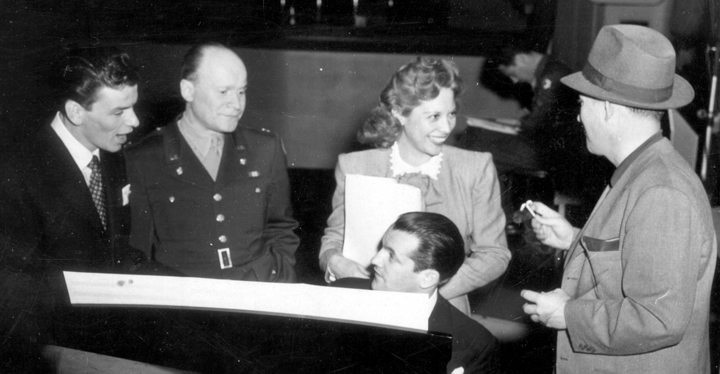
Armed Forces Radio Show entitled Command Performance with (L-R) Frank Sinatra, Major Mann Holiner, Dinah Shore, Bing Crosby, Pianist (Unknown) at CBS Studios, Hollywood, California, ca. 1944. (Photo: Wikimedia)
“From Hollywood, California, the U.S. Army and the U.S. Air Force bring you a light romantic comedy titled The Critics Choice, starring the lovely young Broadway and Hollywood stage, screen, and radio personality, Miss Janet Blair.”
Opening line from The Critics Choice
Voice of the Army, Program 447
The CKUA vault is in fact a series of secure archive and storage rooms that house a diverse collection of audio files, records, and music-related artifacts and memorabilia. Among the more intriguing pieces in CKUA’s collection are dozens of 16-inch transcription discs. These large format records, also referred to as broadcast transcription discs, were used by radio stations between the late 1920s and 1960s. CKUA’s transcription disc collection includes discs produced in the 1940s by Paramount Radio Recording, Lang-Worth Feature Programs, the American Legion, the U.S. Army Recruiting Service, the U.S. Navy Recruiting Service, and the U.S. War and Navy Departments Armed Forces Radio Service.

A 16-inch transcription disc from CKUA’s collection alongside (L-R) a 10-inch 78 record, a 7-inch 45 record, and a 5-inch CD.
During the Second World War, the Armed Forces Radio Service distributed thousands of transcription discs to radio stations around the world. These discs included music and variety shows performed by Hollywood A-list actors and entertainers recorded in an effort to boost the morale of troops in the field. Big-name stars such as Mary Astor, Janet Blair, Helen Hayes, Robert Ryan, and Jimmy Stewart lent their voices and talents to the transcription disc program. This was all done under the auspices of the United States War Department’s newly formed Morale Service Division, later called Special Services.
In 1944, at the request of the U.S. Army, CKUA began transmitting news reports and transcription disc programs to army personnel working in Alaska. This was done via telephone lines installed during the construction of the Alaska Highway in 1942. CKUA transmitted to CFWH Whitehorse for re-broadcast by the U.S. Army. As a non-commercial station, CKUA could easily adapt its programming to accommodate this type of special request. However, while the CKUA programs were being broadcast, no one could make a phone call in or out of the Yukon. Control of CFWH was transferred to the Canadian Army in 1946. The broadcasting arrangement between CKUA and CFWH continued until the early 1950s when CFWH joined the CBC radio network.
Transcription discs represent an intriguing chapter in 20th century radio and music history. As a technologically-driven industry, radio constantly adapts to changes in formats and tastes. As evolving technologies create obsolescence, CKUA’s transcription disc collection is significant because it contains historic audio files in the original format. That CKUA also owns a working transcription disc player makes this collection even more exceptional. Transcription discs also represents a tangible connection to CKUA’s contributions to the war effort of the 1940s.
Transcription discs produced throughout the mid-20th century are collected today by audiophiles, vinyl aficionados, and old-time radio show enthusiasts alike. You can listen to and watch videos of transcription discs being played on YouTube.
References and Further Reading
Callahan, North. North Callahan: An Exciting Life. Cranbury: Cornwall Books, 2005.
Mackenzie, Harry. The Directory of the Armed Forces Radio Service Series. Westport: Greenwood Press, 1999.
Old Radio Programs – An Archive of Historical Old Radio Broadcasts.
Spragg, Dennis M., “The Armed Forces Radio Service,” Glenn Miller Archive – University of
Colorado Boulder, September 2013.
2017 Researched and written by historian Anna M. Rebus, BA, BA, MA, MA (in progress)


